Many species of fly are pollinators, a role for which they receive little common recognition. Perhaps also not so well-known is that some species of flies indulge in bubble-blowing.
A few months ago I was looking at the tiny flowers on a Tassel-berry tree (Antidesma venosum) in our garden. As the common name implies, the most noticeably characteristic of the tree are the berries, which hang down in long tassels. These berries are preceded by less conspicuous pale flowers. I was surprised when I noticed that the flowers were being visited by several different kinds of flies, apparently seeking nectar and pollen.
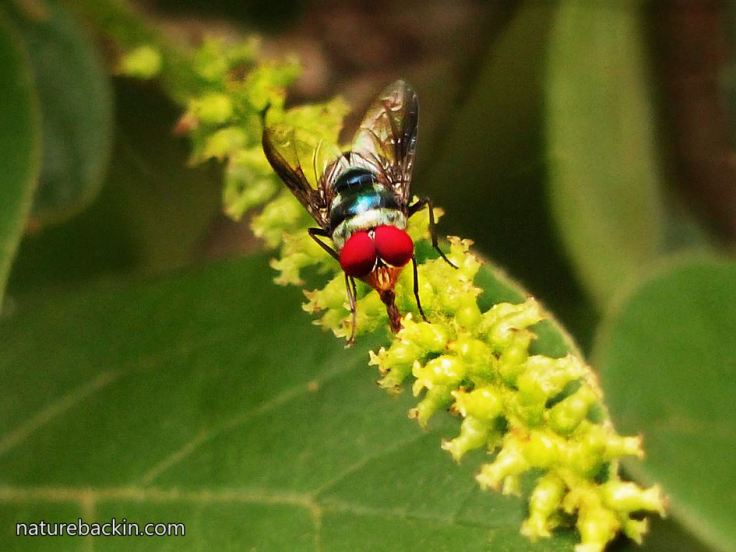
Showing off its colours, this male blow fly sucks up nectar from the flowers of the Tassel-berry tree in our garden
Blow flies are part of the Calliphoridae family of flies (Diptera). Typically, most species of blow fly lay their eggs on fresh carcasses. The eggs hatch into larvae (maggots) that eat the flesh as it starts to rot. The maggots of some species of blow fly have been used in human medicine, to help clean wounds by eating the surrounding decayed flesh.
Also beneficial to us humans, blow fly maggots are useful forensic indicators and they assist in speeding up the necessary process of decay. A recent research paper reports that blow flies play a major role in the pollination of fruit orchards, including mangoes. Blow flies have the advantage of being cheaper and easier to raise and maintain as orchard pollinators than, for instance, honeybees (Saeed et al. 2016).
Once larval growth is complete, blow fly maggots burrow into the soil to pupate, and in the next part of the cycle emerge as adult flies. In their adult form, blow flies eat flower nectar, plant sap and other sugary substances, and in the process of visiting flowers in search of food they act as pollinators.
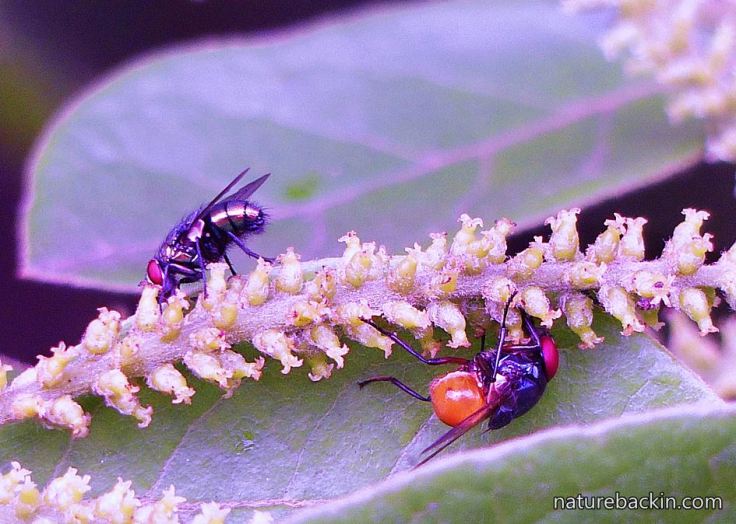
Pollinating flies busily foraging in the tiny flowers
Also feeding from the flowers on the Tassel-berry tree were flies from the large and diverse Tachinidae family. All Tachinid flies are endoparasites, that is in larval form they live inside the bodies of their hosts, usually the caterpillars (larvae) of butterflies and moths. Female Tachinid flies lay their eggs directly into or onto the bodies of the larvae of the host species, or they lay their eggs on the leaves that the host caterpillars eat. The fly eggs hatch inside the host larvae. Most hosts die as a result of this, and once fully developed the Tachinid fly larvae go on to pupate in the soil.

Like the blow flies, adult Tachinid flies are often found visiting flowers, eating nectar, pollen or honeydew. The characteristic bristles at the end of the abdomen can be seen in this photo
Tachinid flies significantly control the numbers of insects that they parasitise, including insects that feed on agricultural crops and on garden plants. Some gardeners actively encourage Tachinid flies, regarding them as “natural pest controllers”. By controlling species that can cause significant agricultural crop losses, Tachinid flies may play an important role in the economy as biological control agents.
Many insects, including many species of fly, indulge in something called bubble blowing. These bubbles are not airy bubbles; they are round droplets of previously ingested fluids like nectar. There are various theories as to why some insects do this, with the most prevalent theory being that the process aids digestion.
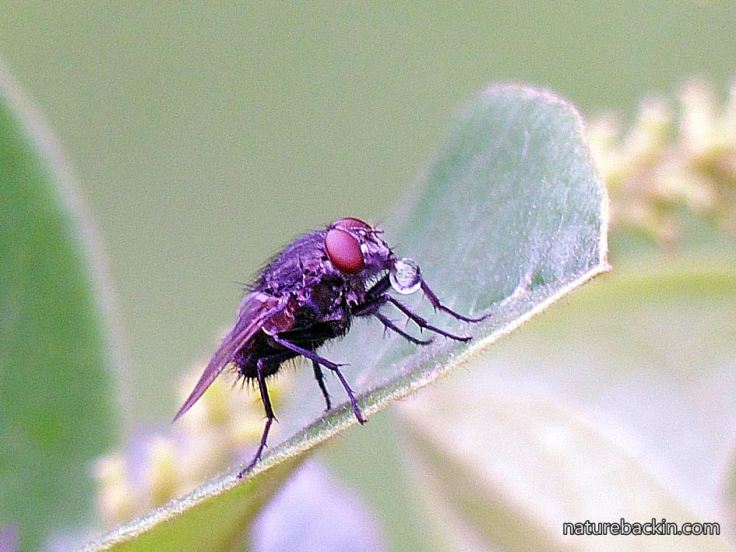
A Tachinid fly sitting motionless on a leaf of the Tassel-berry displaying a bubble-like fluid droplet
Flies usually get a negative press, so reiterating their detrimental aspects here seems redundant. Instead, I am interested to share something about the incredible diversity of flies, and that the natural functions they perform are surprisingly complex, and, from a human point of view, often beneficial too.
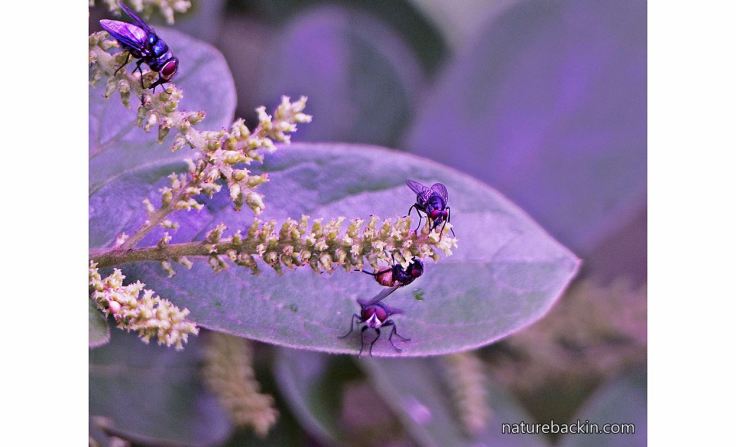
Sources: Blow Fly. Insects. http://www.everythingabout.net/articles/biology/animals/arthropods/insects/flies/blow_fly/; Parasitoids: Tachinid Fly (Diptera). [n.d.] Home and Garden Information Center, College of Agriculture and Natural Resources, University of Maryland Extension. https://extension.umd.edu/hgic/insects/parasitoids-tachinid-fly-diptera; Saeed, S., Naqqash, M. N., Jaleel, W., Saeed, Q., & Ghouri, F. 2016. The effect of blow flies (Diptera: Calliphoridae) on the size and weight of mangos (Mangifera indica L.). PeerJ, 4, e2076. http://doi.org/10.7717/peerj.2076; Scholtz, C.H. and Holm, E. 1985. Insects of Southern Africa. Durban: Butterworths.
Posted by Carol

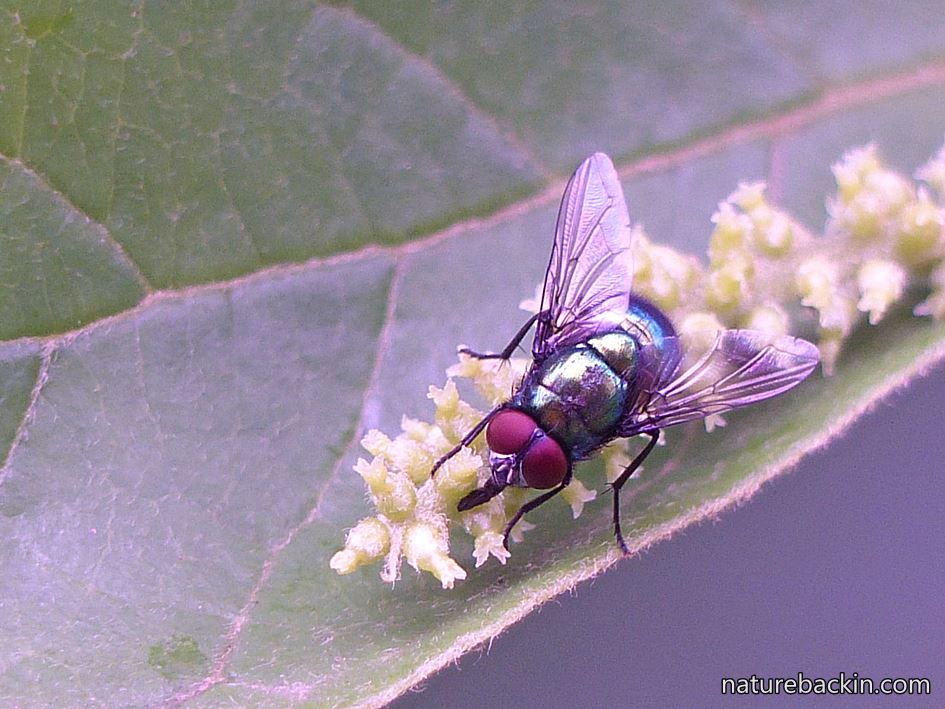







October 9, 2017 at 2:20 am
I am blown away by your attention to detail. Pollinators, and really, any native herbivorous insect, are a blessing to a healthy, thriving garden. I’ve learned more about blow flies and Tachinid flies in the past few moments than in the past few years.
LikeLiked by 1 person
October 10, 2017 at 6:12 am
Thanks so much. I was fortunate to have an entomologist friend help identify the flies. I learnt a lot too when reading for this post. I agree with what you say about the benefit of native insects to healthy gardens 🙂 And they attract and feed birds and other creatures too!
LikeLike
September 21, 2017 at 7:34 pm
I’ve been taking more notice of flies over the last few years and am learning to appreciate the role they play in the less glamorous aspects of the circle of life. I learnt some interesting stuff from your post – the bubble-blowing is fascinating, something I was completely unaware of and have not witnessed, so will watch out for that. I know they play their part in pollination but also was unaware that they are actually bred to do the job! Thank you for an interesting and informative post.
LikeLiked by 1 person
September 22, 2017 at 12:55 pm
Thanks Theresa. I am also learning that flies are more varied and ecologically important than I’d realised, I’d be interested to know if you do come across any bubble-blowing. This is the only time I have noticed it, but will also be on the lookout from now on.
LikeLiked by 1 person
August 12, 2017 at 3:28 pm
Thank you for teaching me more about flies. Yet another species with lots of bad press!
LikeLiked by 1 person
August 12, 2017 at 5:22 pm
Yes that’s true – another class of creatures to add to the list. I find it fascinating to learn about the less well-known attributes of creatures that are generally so misunderstood.
LikeLike
August 12, 2017 at 2:22 pm
Excellent images and great information – I, for one, never thought of flies as necessary and important in our environment.
LikeLiked by 1 person
August 12, 2017 at 5:17 pm
Thanks so much Hester. Finding the flies on the flowers led to me changing my assumptions too.
LikeLiked by 1 person
August 11, 2017 at 8:52 pm
I knew flies are important pollinators, but I didn’t know they blow bubbles! Great photos, Carol.
LikeLiked by 1 person
August 12, 2017 at 5:15 pm
Thanks Eliza. I know that you are a promoter of pollinators and its great that flies are part of the bigger picture. (I think there is widespread assumption out there that honeybees are the only pollinators.) The bubble-blowing is awesome. An entomologist friend inspired me find out a bit more about it. I accidentally bumped the white-balance button on my camera while taking these pics and nearly ruined them completely! I managed to salvage them by fiddling with the colour a bit. I suppose its called learning the hard way.
LikeLiked by 1 person
August 11, 2017 at 8:45 pm
I was struck by the handsome appearance of these flies, and the positive press you gave them has given me pause for thought. I’ll look at them with fresh eyes in future.
LikeLiked by 1 person
August 12, 2017 at 5:08 pm
Yes, finding out a bit about these flies has changed my perceptions too 🙂
LikeLike
August 11, 2017 at 8:39 pm
Very interesting read. Never new about the benefits of flies up until now.
LikeLiked by 1 person
August 12, 2017 at 5:06 pm
Yup, I am learning too 🙂 I am so pleased you found it interested. Thanks.
LikeLiked by 1 person
August 11, 2017 at 5:08 pm
Amazing color!!
LikeLiked by 2 people
August 12, 2017 at 5:05 pm
Yes it is. The humble fly in gorgeous colours!
LikeLiked by 1 person
August 11, 2017 at 3:34 pm
I was late to the party in understanding the importance of flies. Once I started to get to grips with their vital role I became something of a fly evangelist and I am delighted by your extraordinary photographs (I had no idea about the bubbles and to see one is truly magical) and the very clear and helpful text.
LikeLiked by 2 people
August 12, 2017 at 5:03 pm
It seems I am following the same path as you – late to the party, and then championing the underdog/fly. I totally get what you say about the urge to become a fly evangelist 🙂 The more I learn about the natural world, one thing leads to another – there is so much more to find out about and be fascinated by!
LikeLiked by 1 person
August 12, 2017 at 5:12 pm
And it is one of the many things I love about following your blog …. what you talk about is reachable … it’s in the garden, in the neighborhood. Your enthusiasm for the natural world is infectious and it is attainable (doesn’t matter that continents divide us … we all have the same sorts of things going on under our noses if we are prepared to look 👀). Keep doing what you do … its very very good 😊
LikeLiked by 1 person
August 12, 2017 at 5:59 pm
Thank you so much Osyth. How heartwarming to connect across continents. I am truly touched by your comment.
LikeLiked by 1 person
August 12, 2017 at 6:28 pm
I’m not at all a fan of anything social media and this shrinking planet of ours but there are good things. Connecting with you is one 🙂
LikeLiked by 1 person
August 11, 2017 at 3:15 pm
Not the most beautiful creatures on the Earth.
LikeLike
August 12, 2017 at 4:56 pm
Well, I know some entomologists who are completely besotted with flies, each having their favourites. So I guess it really does go to show that beauty is in the eye of the beholder 🙂
LikeLiked by 1 person
August 12, 2017 at 8:08 pm
You are right. For them we can seem monsters.
LikeLiked by 1 person
August 13, 2017 at 5:32 am
☺
LikeLike